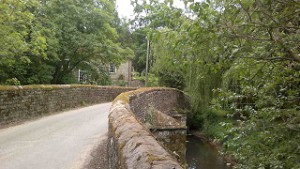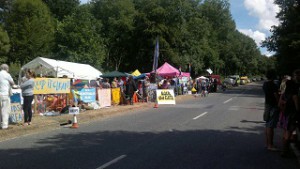Cretaceous fossils, none of them valuable, are building up on my windowsill. It is hard to keep away from the Weald at this time of year. From Haywards Heath I cross the ridges to the Sussex Ouse and follow it over stile and footbridge, meadows, woods and glades. All of it was our industrial heartland five hundred years ago.

Sussex Ouse
I am headed, of course, for Balcombe to see for myself. Oh, what an eyesore! I refer not to the fracking site itself, but to the circus of tents, caravans, stalls, banners, police cars and temporary traffic signs straddling both verges of a country road for half a mile, with all the warning signs that it is going to turn into a permanent protest camp. “Dirty energy!” I read on an aging Peugeot van. “70% of Arctic ice gone,” “Our children say No,” “Honk if you agree,” and (in fairness) “Where are you dumping waste water?” – to my mind the only real issue in all this. You can just see the drilling rig from a specially created viewing point if you crane your neck. It is deep in a commercial conifer plantation, bounded by an A-road, the railway and a business park, which has probably not been in a true state of nature for centuries.

Protest camp
The Palaeozoic floor is poorly understood in this area for the very reason that it is a mile and a half of solid rock below the surface aquifer feeding Ardingley Reservoir. My guess is that Cuadrilla are exploring a hidden Lower Carboniferous basin like those exposed in South Wales and mid-Devon, and I am in high hopes that new light will be shed on the Variscan orogeny.
The village and the rest of its surroundings are as lovely as ever. Refreshments at the famous tea rooms and then to the station. I spot a couple of weekend ecowarriors also awaiting the 4.30 to town. As a rule of thumb, if their sort are against something I am for it. Next time I mean to track down the Balcombe oil well which recently closed down after thirty years.